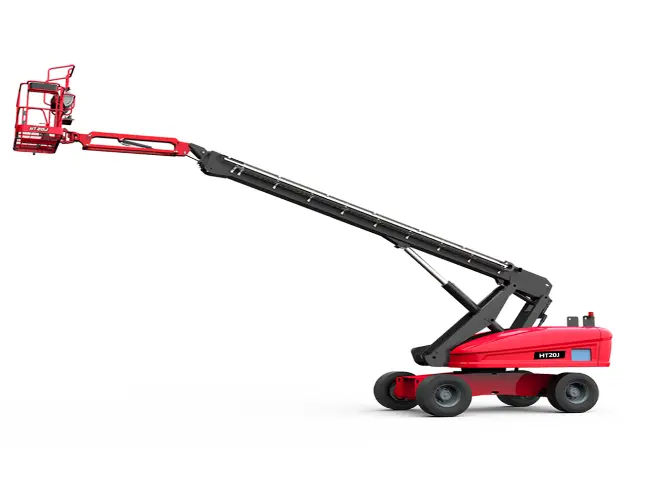Knuckle Booms vs. Straight Booms. What are the Differences?
If you're planning a construction project that requires working at significant heights, you may be considering using an aerial platform. With various options available, such as scissor lifts and cherry pickers, choosing the right one can be challenging. However, if you need to reach extreme heights in a confined space, a boom lift could be the ideal solution.
Boom lifts generally offer smaller platforms compared to scissor lifts, typically designed for a single worker. They come in various sizes, ranging from 10 meters to 60 meters in height, and can be powered by either electricity or diesel. One of the main differences between boom lifts lies in their design: knuckle booms and straight boom lifts.
Let’s explore the key distinctions between these two types of boom lifts and help you determine which one is the best fit for your project.
What is a Knuckle Boom Lift?
Knuckle boom lifts are aerial platforms designed to access hard-to-reach areas. Most models feature a 360-degree rotating base, allowing them to swivel in any direction. The defining characteristic of knuckle boom lifts is their jointed arm and segmented boom sections, often with two or three joints, which resemble the movement of a finger—hence the name "knuckle booms."
These lifts offer exceptional dexterity and versatility, with an impressive reach and working height of up to 45 meters, enabling access to areas that are up, over, and around obstacles. The articulating arm, or jib, with its "knuckles," can maneuver around corners, over walls, and past obstacles, providing workers with access to locations that would otherwise be unreachable.
Knuckle booms are also suitable for indoor use due to their ability to bend and contract, allowing them to fit into tight spaces. Some models feature quiet, emission-free engines and run on electric power, making them ideal for indoor environments.
Best for:
- Hard-to-reach areas on your worksite
- Jobs that require you to adjust your lift position frequently
- Working in a smaller or tighter space
- Up-and-over work spaces
What is a Straight Boom Lift?
Straight boom lifts provide excellent outreach, similar to knuckle boom lifts, and can extend even farther—up to 56 meters in some models. However, unlike knuckle booms, they do not have articulated joints, making them less flexible in tight spaces. Instead of bending, straight boom lifts extend and contract like a telescope, allowing them to reach both straight up and out at an angle.
These lifts are equipped with rugged tires, making them well-suited for rough terrain. Powered by diesel engines, straight boom lifts are typically used outdoors, where their strength and reach can be fully utilized.
Best for:
- Reaching great distances for specific tasks (up to 56 meters)
- Operating on rough terrain
- Lifting materials to high positions using elevated work platforms
How to Choose the Right Boom Lift
When choosing between knuckle and straight boom lifts, it’s essential to consider the specifics of your project and the layout of your work area. Key questions to ask include: How high or far out do you need to reach? What obstacles (e.g., walls, trees, power lines) will you encounter? Will the lift be used indoors or outdoors? Will you be working on rugged terrain?
Agility vs. Versatility
The most noticeable difference between these two types of lifts lies in their design. Knuckle boom lifts have multiple pivot points, allowing for up-and-over access, which makes them ideal for navigating tight spaces and reaching hard-to-access spots. In contrast, straight boom lifts extend in a straight line, offering excellent reach but with less flexibility in maneuvering around obstacles.
- Knuckle boom lifts are ideal for reaching over or around places such as ceiling joists, roofs, warehouse shelves, etc.
- Straight boom lifts have more versatility to perform tasks that may be higher or farther out. They’re great for working at distances on worksites where operating closely isn’t an option. Straight booms are beneficial for tasks such as, building bridges and working high up on skyscrapers.
Vertical and Horizontal Reach
One key difference between the two types of lifts is their reach capacity. Straight boom lifts typically offer greater vertical and horizontal reach compared to knuckle booms, with some models reaching up to 56 meters. However, straight booms require more space to operate effectively and need ample room to achieve their full extension.
Knuckle boom lifts, while offering less reach than straight booms, excel in maneuverability around obstacles, making them ideal for tight spaces.
Indoor vs. Outdoor Use
For outdoor jobs on expansive sites, straight boom lifts are a better option, particularly when working in areas with a lot of space to extend and reach high or distant locations.
Knuckle boom lifts, on the other hand, are well-suited for indoor work where navigating narrow aisles or tight areas is required. They are perfect for tasks such as inventory scanning in warehouses or maintenance work like plumbing or ceiling repairs.
Straight boom lifts are commonly used in outdoor construction tasks, including electrical work, painting, and bridgework, where high-reaching and far-reaching capabilities are needed.
Type of Engine
Choosing the right power source is crucial when selecting a boom lift. Indoor applications typically require an electric lift, while outdoor tasks may demand the higher power output of a diesel engine.
Diesel-Powered Engines
Diesel engines are commonly used for outdoor operations due to the fumes they emit. Available in both straight and knuckle boom configurations, these lifts come in larger models with extended reach: straight boom lifts range from 12 to 56 meters, while knuckle boom lifts range from 10 to 45 meters. Diesel engines provide more power, making them ideal for navigating rough terrain.
Electric-Powered Engines
Electric-powered engines, typically used for smaller knuckle boom lifts (10 to 18 meters), are well-suited for indoor use. These battery-operated lifts produce no fumes and operate much more quietly, making them perfect for environments that require minimal disruption.





